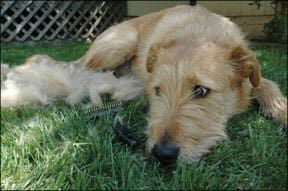Spring is here and so is shedding season! Suddenly, every carpet in the house is woven with dog hair. Otto has what can be best described as a “combination coat” (I just made that up). Much of his outer coat is made up of long, stiff, straight hair – resembling that from a German Shepherd, or maybe a Labrador – that seems to wriggle into the carpet pattern itself. My vacuum is helpless in the face of this hair. Admittedly, it’s not a great vacuum, so cleaning the few carpets we have has turned into aerobic exercise.

Otto was not delighted with being brushed and having his hair pulled out, but he did like the attention, affection, and treats; overall the experience was a wash!
Quite some time ago, Black & Decker sent me a new DustBuster (handheld power vacuum) to try. This one is the “Retriever Pet Series Cyclonic Action,” and it plugs in; it’s powerful, unlike wimpy cordless models I’ve owned in my past. Used with its “turbo brush” (spinning rubber bristles) attachment, it’s fantastic at getting pet hair off our couch. But with an approximately three-inch intake, it’s not useful for cleaning entire carpets.
My sister Pam has been telling me I absolutely have to get the same vacuum she recently bought: A Dyson “Animal.” She has three small white dogs and swears that she had enough hair to make another, larger dog out of the stuff that the new vacuum cleaned up on its inaugural tour through her house. “I had forgotten what a dark color my couches actually were!” she reported, incredulous. “And my rugs are beautiful!”
Otto also has a softer, shorter coat underneath, which is coming out by the literal handful – although, curiously, this is not the hair we find so much of in the house. This hair mostly comes out through petting. You can’t pet him right now without inadvertently collecting a pile of loose hair at the end of your handstroke.
The other day, I used a “grooming rake” – a tool with short metal teeth – to loosen and pull out some of this thick undercoat, and quickly amassed a big pile of hair on the lawn. But the tool didn’t remove any of that long, wiry hair on the top of his coat, and it’s shedding, too. I started pulling this long hair – gently! – and found it came out pretty easily. I know that this is an actual grooming technique; I have a good friend who has a German Wire-Haired Pointer, and she’s paid good money to have him professionally “hand-stripped” (as opposed to clipped with clippers). Between the raking and pulling, Otto looks much more sleek.
Trip to the vet
One of the reasons I wanted to clean Otto up was for a trip to the vet’s office. I took him in for a few reasons.
The first is exciting. Lisa Rodier, a regular contributor to WDJ (and who interviewed trainer Victoria Stilwell for the article on page 4 of this issue), is working on an article for us about the new DNA tests that are supposed to be able to determine the genetic contributors to any mixed breed dog. There are two leading companies offering this service; the Canine Heritage Breed Test analyzes some of the dog’s cheek cells (which you collect with a special swab that the company provides in its test kit). The Wisdom Panel Mixed Breed Analysis requires a sample of blood, drawn by a participating veterinarian. For purposes of the article, Lisa and I decided to have both tests done on the same dog, so we could compare the results. And Otto got to be our test subject! (We don’t have the results yet, but will share them with you in an article in the June or July issue.)

The goats didn’t like the looks or behavior of the new dog. They reared and stomped their feet at Otto.
I haven’t taken Otto to any veterinarian since I adopted him last June. In another month, he’d be due for two bits of routine veterinary business, so I combined a trip for the blood draw for the DNA test with a heartworm test and a rabies vaccine.
Heartworm
Where I live, heartworm infections in dogs are common. I’ve lived in parts of California where I made a calculated decision to forego heartworm preventative medication for my dogs, based on the incredibly low prevalence of the disease in those areas.
Oroville, in contrast, seems to offer an ideal climate to mosquitoes – the vital carriers of several life stages of the heartworm. There also seems to be an ample reservoir of the infection in our local wildlife – and perhaps the unprotected dogs of the area, too. Employees of the animal shelter in our town can attest that most dogs who are kept outdoors and who aren’t routinely given heartworm preventatives will contract a lethal infection of the parasites.
As we reported in articles such as “Parasites Within Parasites” (August 2006); “Heartworm: Don’t Take It Lightly” (March 2006); and “Reflections on Heartworm” (August 2002); there are holistic vets and some dog owners who feel that the potential dangers of heartworm preventive medications outweigh the health risks to the dog. Instead, these individuals focus on a two-pronged approach to preventing heartworm disease.

Otto is inextricably drawn to the more defensive goat. Her assertive behavior intrigued him. At this point, he’s more curious than scared.
The first goal is to boost the dog’s immune system – often through biologically appropriate raw diets, and herbal and other supplements. The idea is to increase the ability of the dog’s immune system to detect and kill any larval forms of the heartworm that they are infected with (through the bite of a carrier mosquito).
It’s not as farfetched as it might sound. Researchers are aware that some dogs are somehow able to live long, symptom-free lives despite light infections with adult heartworms. And other dogs seem to be able to resist the infections so well that larval heartworms never survive to maturity; they test heartworm-free in spite of regular exposure to infected mosquitoes.
Other owners take a different (or a complementary) tack: they focus on protecting their dogs from mosquitoes, often with nontoxic mosquito repellents made of strong essential oils.
While I respect dog owners who are able to succeed at these efforts, I’m not brave enough to seek out alternatives to conventional heartworm preventatives; nor am I particularly worried about medication’s side effects. In contrast, I’m scared to death of heartworm infections. I’ve seen dogs with severe heartworms infections, and it’s not pretty. I’ve also seen dogs go through treatment for an infection, and that’s nerve-wracking as well. Immediately following treatment, the dog requires total cage-rest while the dead worms are shed from his circulatory tract into his lungs; complications are common. Treated dogs sometimes need steroids, antibiotics, fluids, and aggressive nursing care to pull through.

The feeling was mutual. Otto repeatedly rushed the fence barking. He seems more scared than predatory, though.
I do administer heartworm preventative to Otto on a slightly longer schedule than is recommended by the manufacturer (as described in detail in the March 2006 article mentioned earlier). I give the medication to Otto every 40 to 45 days.
Most veterinarians require a negative heartworm test each year, before they will renew a dog’s prescription for preventative; that’s one of the reasons I took Otto to the vet. Happily, his test was negative, as I hope it always will be.
Rabies vaccines
Otto received a one-year rabies vaccine in the shelter from which I adopted him, not quite a year ago. Given that he was brought into the shelter as a stray of approximately six months of age, he may or may not have received other rabies vaccines before that.
Administration of the rabies vaccine is a matter of state law. To protect the health of the (human) population from this fatal disease, public health officials in each state enforce laws that decide whether dogs must receive a vaccination against rabies annually, or every three years. California is a three-year state.

He turned away from the goats and toward me each time I said “Off!” Our daily “off” practice is paying, um, off.
The rabies vaccine causes the greatest number of adverse reactions of the most common vaccines that dogs are given. As a result, owners of chronically ill dogs, or those who have had previous vaccine reactions, might want to consider applying for a rabies waiver. However, Otto is a young, healthy dog, and we live in an area where skunks, bats, raccoons, and other wildlife carriers of rabies are common. Unvaccinated feral cats, too, are quite common in this area. Skunks and feral cats were both living under our house before we moved in, and Otto patrols our property nightly to prevent intrusions by these potential carriers of disease. I felt fine about arranging for a three-year rabies vaccine.
Big surprise
Since this was only Otto’s second trip to a veterinarian (and I brought him to a different clinic than the one I brought him to after I adopted him), I came equipped with a bait bag and a lot of Otto’s favorite treats: cut-up hot dogs. I gave him lots of treats for sits, downs, and stands, keeping him distracted from the mewing cat in a carrier across the waiting room.

My friend doled out crackers for all the dogs and goats. Otto was polite, but after hot dogs, the crackers were not yummy enough to hold his interest.
When the cat and her family were called into the exam room, I took Otto over to the scale in the waiting room, and although it took a lot of treats to get him to step on it, I was finally able to see Otto’s current weight. It was a big surprise! When I adopted him last June, Otto weighed 44 pounds, and it has not seemed to me that he’s grown very much. He lost a little puppy flab, and he’s put on more muscle, but he doesn’t seem significantly bigger than when I got him. In fact, he’s 20 pounds heavier!
This wouldn’t be a big deal, except for the fact that I’ve been giving him heartworm preventative for dogs that weigh from 25 to 50 pounds; he should have been receiving a higher dose. I bought a new supply of the larger dose.
I adjust the amount of dry dog food that I feed Otto based on the amount of exercise he is getting and on how his weight looks. I give him a little less on the days when we don’t manage to go out for a long walk or hard run, and give him a bit more on the days when he burns more calories. And when he looks a little heavy, I reduce his portions a bit more. This is pretty unscientific, but the vet who examined him agreed that his weight looks good; he is healthy.
Getting his goat
Otto’s weight gain was my surprise of the month. Meeting a pair of goats was his!
We’ve passed horses on walks before, and his response to them was decidedly ho-hum. So I really didn’t expect Otto’s agitated reaction to the goats.
I recently started going for mountain bike rides with a new friend, Leonora. We’ve met on the trails near my house before, and one recent Saturday, Leonora proposed a ride from her house, which is located about a dozen miles out of town, and higher up in the foothills than the town of Oroville. She also invited me to bring Otto, so he could play with her dogs; they could all hang out together in her quarter-acre, fenced dog run while we went riding. Otto gets along especially well with three-year-old Matilda. He’s slightly less crazy about Leonora’s newest dog, a five-month-old mixed-breed pup named Lena, and he pretty much ignores tiny S’mores, a Chihuahua.

The behavior of the goats, as much as Otto’s continued interest in them, tells me that he should be watched carefully around them for some time to come.
When we got to Leonora’s house, Otto was so glad to see the dogs that he failed to notice the goats for probably the first hour that we were there. Suddenly I heard a loud, “Wooo, woo woo woo!” Recognizing Otto’s “watchdog” bark, I ran around the corner of Leonora’s house to see two very agitated goats and one very aroused Otto facing each other across a wire mesh fence. All three animals had all the hair on their backs standing straight up; I didn’t know goats did that, too!
The goats are familiar with Leonora’s dogs; they even play and are affectionate with gentle Matilda. But they took an immediate exception to Otto; there was something about him that just looked like trouble to them.
One thing that I have learned is that you never know when an opportunity to teach your dog something new will arise, so it’s best to always carry treats. I had the benefit of a bait bag full of cut-up hot dogs, so in a clear voice, I said “Otto! Off!” And because we practice this exercise practically every day, he immediately looked away from the goats and started trotting toward me for the reward he knew was forthcoming. Jackpot! What a good dog. I gave him a steady stream of hot dog bits and praise, and then we headed back to the goat pen to work a little more.
The goats were still on red alert, so Leonora headed into the pen with Matilda, to pet and calm them. If it seemed that Otto might try to attack the goats, I would have put him on-leash, but given that he responded so well to my “off” cue, I felt I would be able to control him well enough to avoid real trouble.
I was so proud of him. I allowed him to approach the fence to get a closer look, and I said “Off!” if he barked or rushed at the goats. Each time I said “Off!” he turned to me for a treat, and even seemed to put his fur down and forget about the strange hoofed animals for a few seconds.
After a few minutes, Leonora came out of the pen and started handing out crackers to all the animals, canine and caprine (the latter means goats; I just learned that). The goats calmed down, and all the dogs sat politely for their crackers. After a few treats, Otto apparently decided that crackers weren’t that great, and he broke ranks to approach the fence again. However, as before, he turned away the moment I said “Off!” and looked to me for some more hot dogs. I decided to end the day’s lesson on that note, and took him back up to the house. The goats still didn’t trust him, and I wouldn’t at this point, either. But I think we made good progress for his first “getting along with livestock” lesson.






